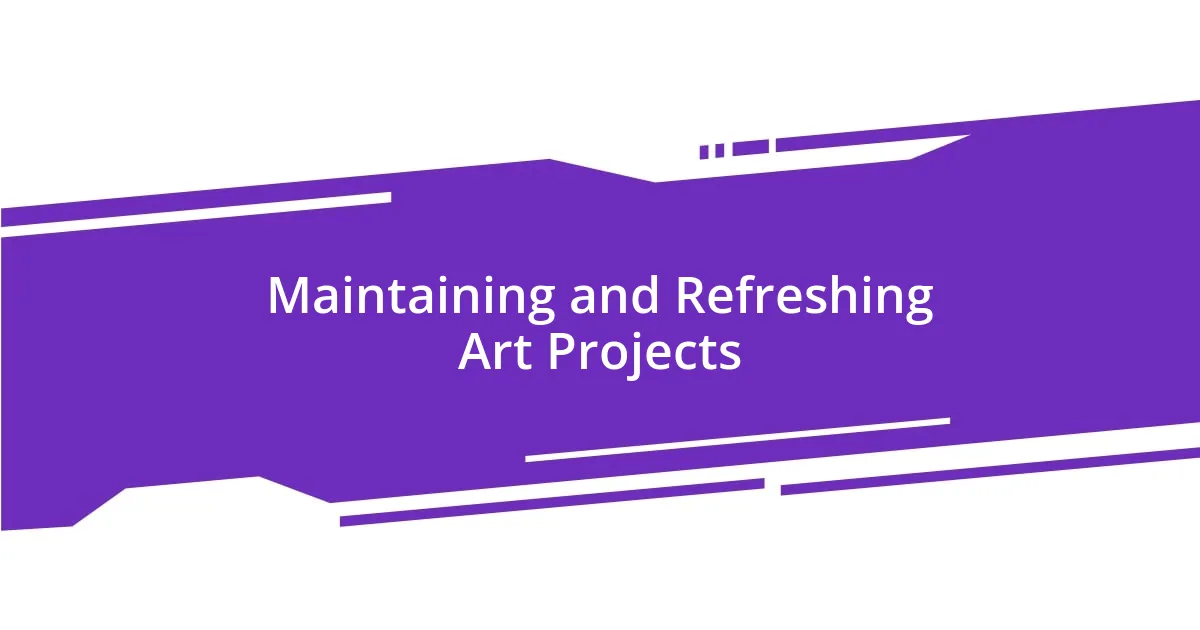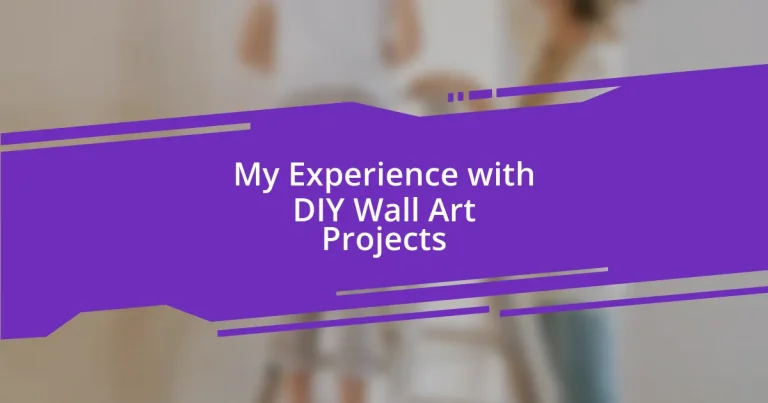Key takeaways:
- Embrace the creative process and find joy in simplicity when starting DIY art projects.
- Investing in quality materials and tools significantly enhances the outcome and experience of art creation.
- Drawing inspiration from everyday life and creating mood boards can spark innovative design ideas.
- Displaying artwork thoughtfully, through framing or creating gallery walls, elevates the impact of your creations.

Getting Started with DIY Art
When I first dipped my toes into the world of DIY wall art, I felt a blend of excitement and trepidation. What if my vision didn’t match the reality? I quickly learned that letting go of perfection and embracing the creative process was the key. It’s liberating to realize that the journey itself often turns out to be just as rewarding as the final product.
Choosing a project is your first big step, and oh, how overwhelming that can feel! I remember scrolling through countless ideas online, each one calling to me in different ways. I found it helpful to start with something simple, like a geometric painting or a photo collage. This made my foray into DIY art less intimidating and allowed me to build my confidence along the way.
Once you’ve selected your project, gather your materials—it’s like preparing for an adventure. I always make sure to have everything on hand because nothing kills creativity faster than an unexpected trip to the store. Plus, I love the thrill of seeing how different supplies can spark new ideas, turning an ordinary afternoon into something special. What will you create first?

Choosing the Right Materials
Choosing the right materials for your DIY wall art can truly make or break your project. I still remember the first time I ventured into making a canvas painting. I was so focused on the colors that I didn’t pay attention to the quality of the canvas and brushes. When I finally started painting, the canvas frayed under my strokes, and the paint didn’t blend like I imagined. This taught me a valuable lesson about investing in good materials; they really can elevate your artistic expression.
I often find myself torn between different types of paint and their finishes. For instance, acrylic paint dries quickly and is easy to work with, making it a fantastic choice for beginners or those on a time crunch. On the other hand, watercolor offers a unique softness and blending capability that can create stunning effects for the right project, though it’s definitely trickier to control. Understanding the properties of each material helps me select the ones that resonate with my vision and style, which makes the creative process feel more seamless and rewarding.
When it comes down to texture, don’t underestimate the impact of mixed media. I’ve experimented with everything from fabric scraps to natural materials like twigs and leaves in my designs. Incorporating various textures not only adds depth but also evokes different feelings. For example, using fabric can create a cozy, homey vibe, while metallic elements often bring a modern touch. Trust me, playing around with textures is a journey; it’s about discovering what moves you and what resonates with your space.
| Material | Best Use |
|---|---|
| Acrylic Paint | Versatile, easy to use, quick drying |
| Watercolor Paint | Soft, blended effects, ideal for delicate designs |
| Canvas | Durable base for paintings |
| Fabric | Cozy texture for mixed media |
| Metallic Elements | Modern finish, eye-catching accents |

Tools for Wall Art Projects
When diving into wall art projects, having the right tools is essential for a smooth creative experience. I vividly recall the excitement of my first project, armed with a few brushes and a can of paint, only to realize the importance of precision tools. A quality set of brushes made a world of difference; I was finally able to achieve those lovely, sweeping strokes I had envisioned. The right tools can elevate not just the outcome, but also the entire creative process.
Here’s a handy list of tools that I’ve found indispensable for DIY wall art projects:
- Brushes: A variety of sizes, including flat, round, and detail brushes for different techniques.
- Palette: For mixing colors easily and getting the right shades before applying.
- Canvas or Wood Panels: Good quality surfaces to paint on; make sure they’re primed for better results.
- Ruler and Pencil: Essential for geometric designs and ensuring straight lines.
- Stencils: Perfect for creating patterns or letters, especially for beginners.
- Adhesives: Strong glue or double-sided tape for mixed media projects can save your art from falling apart.
- Easel: Not crucial, but it can make painting feel more comfortable and professional.
Each project becomes a learning experience, where I often discover new tools that expand my artistic capabilities. For instance, after struggling with the detail in one of my earlier pieces, I decided to invest in a fine-tipped brush, which completely transformed my ability to add intricate designs. There’s a thrill in experimenting with tools and finding the perfect match for your vision.

Step by Step Art Techniques
When I think about step-by-step art techniques, the first thing that comes to mind is the excitement of discovering a new method. I remember my first attempt at creating a layered acrylic pour. It was a bit chaotic, with paint splattering everywhere! But once I understood the technique of pouring in layers and allowing each to dry before adding the next, the process became almost meditative. Have you ever felt that sense of calm as you watch the colors dance and mix? It’s a beautiful way to engage with your creativity.
I find it helpful to break down techniques into manageable steps. For example, when I tackled abstract painting, I began with a simple base. I applied broad strokes of color across the canvas, playing with the blending of hues. Then, I gradually added detail with smaller brushes and contrasting colors. Each layer brought a new dimension to the piece. I’ve often found that patience is key; waiting for the paint to dry can feel torturous, but it’s essential for achieving those crisp, clean lines.
Another technique that stands out from my experience is using stencils to create geometric patterns. On a whim, I tried a geometric design for a guest room and was amazed at the precision it offered. Initially, I was intimidated by the idea of using stencils, thinking it would limit my creativity. However, after a few successful projects, I began to see stencils as a springboard for my imagination rather than a constraint. Have you considered experimenting with stencils in your own art journey? It can open up a whole new world of possibilities!

Tips for Creative Design Ideas
One of my favorite tips for sparking creative design ideas is to draw inspiration from everyday life. I once found the perfect color palette while sipping coffee at my local café. The warm tones of the wood, combined with the rich espresso shades, ignited a project that became one of my favorites. Have you ever looked around and found a stunning combination of colors or shapes that you could translate onto your wall? It’s amazing how much the world around us can fuel our creativity.
Creating a mood board can vastly enhance your design process. I remember gathering swatches of fabric, paint chips, and magazine clippings for a wall art concept I was working on. It was like assembling a jigsaw puzzle of ideas, and it helped clarify my vision. I often ask myself, “What emotions do I want to evoke with this piece?” By laying out my inspirations visually, I found it much easier to create a cohesive and dynamic artwork.
Don’t shy away from experimentation! One memorable moment for me was when I decided to try a different medium on a whim, using spray paint alongside traditional brushes. The blend of textures and methods gave my wall art an unexpected twist that I absolutely loved. Have you tried mixing mediums in your art? It can lead to delightful surprises and push you to step outside your comfort zone. Embracing the unexpected might just be the key to unlocking your next great idea!

Displaying Your Finished Artwork
Displaying your finished artwork is a moment of satisfaction that I genuinely treasure. I once completed a vibrant canvas that felt like a piece of my soul, and finding the perfect spot for it was both challenging and exhilarating. I hung it over my dining table, a place where I could admire it daily and share it with friends. Haven’t you felt joy when showcasing something that represents your creativity?
I’ve also learned that the way you display art can completely change its impact. I remember experimenting with different frames and matting for a watercolor piece. Choosing a sleek black frame made the colors pop, and I was amazed at how much of a difference it made in the presentation. Have you ever considered how a simple frame can elevate your artwork into a statement piece in your home?
Another method I’ve embraced is creating a gallery wall. Initially, I thought it would clutter my space, but it turned out to be a joyous celebration of my creativity! Each piece tells a story, and mixing various styles, like prints, small canvases, or even photographs, adds a unique character to the space. Have you thought about curating a collection of your own creations? It can really turn a blank wall into a captivating narrative of your artistic journey.

Maintaining and Refreshing Art Projects
When it comes to maintaining and refreshing my art projects, I’ve found that a little care goes a long way. For instance, I once noticed my acrylic painting fading slightly after a year in the sun. Instead of panicking, I applied a clear coat to protect it from UV rays, and it brought back the vibrancy I loved. Have you ever considered how environmental factors might affect your artwork?
I make it a habit to reassess my art every few months. One time, I felt my once-bold canvas was getting lost in a sea of neutrals in my living room. I added a few accent pieces around it—a colorful vase and some patterned cushions—and suddenly, it felt like the art was thriving again. Isn’t it magical how small changes can breathe new life into something you’ve created?
Moreover, I enjoy rotating my artwork seasonally. I recall the joy of swapping out a heavy, autumn-themed piece for something light and breezy in the spring. It’s like giving my space a fresh personality. Have you tried this approach? It keeps not only my walls fresh but also my creative spirit alive.














